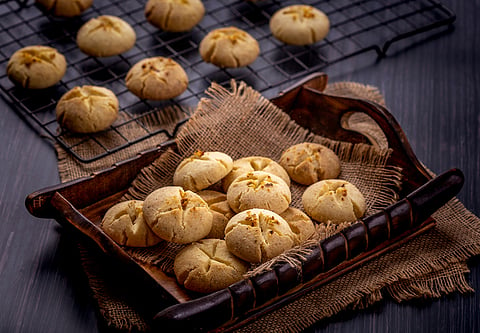
- Destinations
- Experiences
- Stay
- What's new
- Editor’s Picks
- Responsible Tourism
- CampaignsCampaigns
- Subscribe

For any Indian, teatime is sacred. And when that simmering cup is accompanied by select snacks, nankhatai included, there is nothing that deserves to come in the way of that evening hour. A quintessential Indian favourite, the nankhatai trumps its foreigner cousins&ndashthe cookie or the more sublime shortbread&ndashby miles. But is the locally loved indulgence really Indian
The question is not a hint at its presiding popularity in households across the border, in Pakistan, or even a little further, in Afghanistan and Iran. Instead, it is a venture into its origin, which is as layered and rich as the creation itself. But first, there&rsquos a story in its name too.
The Persians Or The Dutch
The first half is made up of the Persian word &ldquonan,&rdquo meaning flatbread and the Afghan word for biscuit, &ldquokhatai,&rdquo completes it. A peek into the &ldquoHobson Jobson A Glossary of Anglo-Indian Words and Phrases&rdquo also suggests the British&rsquos acknowledgement of this crumbly goodness&ndashthey called it the &ldquonuncatie.&rdquo In the book, &ldquonuncatie&rdquo refers to the indulgent cakes created by the Mohammedans in Western India. The Persians were known for their love for the decadent and filling biscuits, as they often resorted to them for energy on long journeys. White, the beloved biscuit, can be traced to the Persians and Arab traders, but the Dutch played a far more significant role.
In the 16th century, when the Dutch explorers found their way to the Indian coast, they brought with themselves their version of a favourite teatime snack, the koejke, made with eggs and toddy, among other obvious ingredients, still used to make the nankhatai. To cater to their snack demands, a Dutch couple set up a bakery in the port city of Surat. While the Dutch called the subcontinent home, their bakery became popular. However, things turned around when the Dutch retracted from the Indian shores.
The Indian Take
After the Dutch couple, the bakery was taken over by a local Iranian employee named Dotivala. For him, things were different. The strong flavours of Koeje appealed to the Dutch but not to the Arabs or even Indians. The inclusion of toddy and eggs in its ingredient list was a serious impediment to its sale. The bakery resorted to making its earnings from selling bread, which didn&rsquot fare well for the bakery. When the unsold bread became crispy, the locals consumed it in what still remains to be the favourite way&ndashby dipping it in hot tea. But another idea struck Dotivala, which led to the creation of the biscuit in the version that is sold today. Dotivala scrapped toddy and egg, baring down the list of ingredients to only wheat flour, sugar and butter, and a pinch of other spices, such as cardamom. And that is how the nankhatai came to be. Since then, the original recipe has fallen into many hands to be moulded in unique ways&ndashbut never swayed away too much from the original.
The nankhatai, apart from being a dependable snack, has also been a foolproof business opportunity owing to its indisputable deliciousness. Observing the biscuit&rsquos draw, Gujarati businessmen realised an opportunity, and so the name was morphed again to &ldquoIrani biscuit&rdquo and shipped to the coast of Bombay.
While the golden, sweet, salty cookies have played a suitable sidekick to the day&rsquos cup of chai for centuries, its layered and rich taste continues to thrill the palates of every Indian household&rsquos oldest to the youngest.
